St Methodius and St Cyril – May 11 First Teachers and Enlighteners of the Slavs
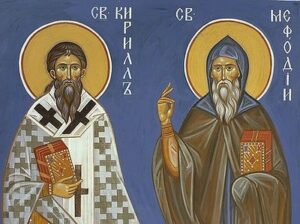
The two Saints Methodius and Cyril were brothers, who brought Orthodoxy to the Slavic peoples of central Europe in the ninth century. Michael (Methodius) and Constantine (Cyril) were born early in the 9th century in Thessaloniki into a noble illustrious and pious Greek senatorial family, living in the Greek city of Thessalonica, but decided to renounce their worldly honors to become priests. The years of their birth are uncertain. Michael, was the eldest of seven brothers, Cyril was the youngest.
Their father Leon, was a Drungarios (drungarios, drungarius – a military rank, commander of a formation known as droungos of the late Roman and Byzantine empires. His jurisdiction included the Slavs of Macedonia of the Byzantine Roman Thema of Thessaloniki. Their mother Maria, is believed to have been Slavic. Both children, were raised in an area, with both Greek and Slavic speakers; thus, endowed with a good knowledge of the two languages and befitting their family’s position, they were well educated.
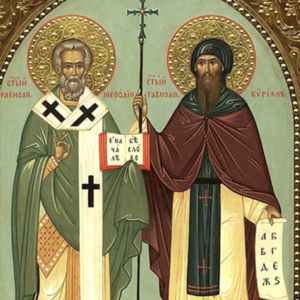
The brothers, lost their father very young, thus they were raised under their uncle Theoctistos (Theoktistos), who was a powerful official in the Byzantine government, responsible for postal services and the diplomatic relations of the empire (842 to 855). Michael was enrolled in the military services, first and he served as a soldier for ten years. Theoctistos arranged a position for him, as an official in the Slavic administration of the empire and later he rose to be the governor in one of the Slavic principalities dependent on the Byzantine Empire, probably Bulgaria, which made it possible for him to learn the Slavic language. He clearly proved himself to be a good administrator. Michael soon went to the monastery at Mount Olympus where he later received monastic tonsure with the name Monastic name Methodius.
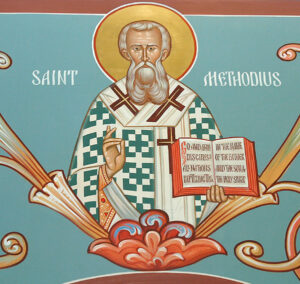
In 843, Theoctistos, invited Constantine to Constantinople to continue his studies at the university there. Constantine was librarian at the Hagia Sophia in Constantinople. Constantine distinguished himself by his great aptitude, and he studied with the emperor Michael under the finest teachers in Constantinople, including Mar Photius, the future Patriarch of Constantinople. He studied, all the sciences of his time, and also knew several languages. He also studied the works of St Gregory the Theologian. Because of his keen mind and penetrating intellect, Constantine was called ‘Philosopher’. He was appointed as instructor in philosophy. The young Constantine’s wisdom and faith were so great that he won a debate with Ananias, the leader of the heretical iconoclasts. After this victory Constantine was sent by the emperor to discuss the Holy Trinity with the Saracens, and again he gained the victory. As Constantine was knowledgeable in theology and had a good command of the Arabic and Hebrew languages, his first state mission to the Abbasid Caliph Al-Mutawakkil was to discuss the principle of the Holy Trinity with Arab theologians and thus improve the Empire’s diplomatic relations with the Abbasid Caliphate.
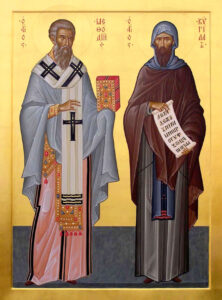
However, he too went on to became a monk He was ordained a deacon in Constantinople and upon the completion of his education, Constantine was ordained to the holy priesthood and was appointed curator of the patriarchal library at the Church of Hagia Sophia. He soon left the capital and went secretly to a monastery and later received monastic tonsure with the name Monastic name Cyril.
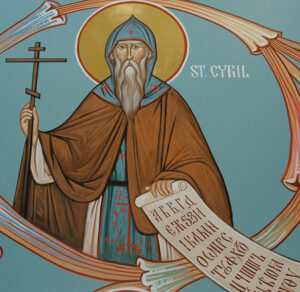
When he returned, Cyril went to his brother Methodius in Olympus, spending his time in unceasing prayer and reading the works of the holy Fathers. The emperor soon summoned both of the holy brothers from the monastery and sent them to preach the Gospel to the Khazars. Along the way they stayed in the city of Korsun, making preparations for their missionary activity. There the holy brothers miraculously discovered the relics of the Hieromartyr Clement, Pope of Rome.
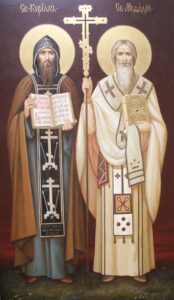
Cyril, met a man in Korsun, speaking the Slavic tongue, from whom he learned from this man how to read and speak this language. The holy brothers went to the Khazars, where they won a debate with Jews and Moslems by preaching the Gospel. On the way home, the brothers again visited Korsun and taking up the relics of St Clement, they returned to Constantinople. St Cyril remained in the capital, but St Methodius was made igumen (hegumen – head of monastery) of the small Polychronion monastery near Mount Olympus, where he lived a life of ascetics as, before. Soon messengers came to the emperor from the Moravian prince Rostislav, who was under pressure from German bishops, with a request to send teachers to Moravia who would be able to preach in the Slavic tongue. The emperor summoned St Cyril and said to him, “You must go there, but it would be better if no one knows about this.”
St Cyril prepared for the new task with fasting and prayer. Here, with the help of his brother St Methodius and the disciples Gorazd, Clement, Sava, Naum and Angelyar, he devised a Slavonic alphabet and translated the books which were necessary for the celebration of the divine services: the Gospel, Epistles, Psalter, and collected services, into the Slavic tongue. This occurred in the year 863. After completing the translation, the holy brothers went to Moravia, where they were received with great honor, and they began to teach the services in the Slavic language. This aroused the malice of the German bishops, who celebrated divine services in the Moravian churches in Latin. They rose up against the holy brothers, convinced that divine services must be done in one of three languages: Hebrew, Greek or Latin. St. Cyril’s knowledge of Syriac is the key to his subsequent creation of the Slavonic alphabet.
In preparation for their mission to the Slavs they devised the Glagolitic alphabet to translate the Holy Scriptures and other Christian writings into what is now called Old Church Slavonic. Glagolitic later developed into the Cyrillic alphabet which is now used in a number of Slavic languages. Their first missionary work was not among the Slavs: When the king of the Khazars (Mongol people who then inhabited much of what is now Russia) petitioned the Emperor Michael to send teachers to instruct his people, the Emperor chose Constantine and Methodius as his emissaries. They converted the Khazar king to the Christian faith, along with many of his nobles and commoners. Later, King Rostislav of Moravia likewise sought teachers of the Christian faith, Cyril and Methodius were again sent forth. This time they devised an alphabet for the Slavic language and used it to translate many of the Greek service books into the language of the people. Thus, the Orthodox people had a privileged to hear the Church’s services in their own tongue.
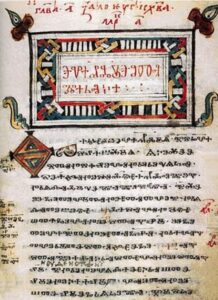
Both brothers were often and repeatedly attacked by Germanic priests of the region, who opposed the use of the common tongue in the liturgy. However, at different times, both brothers had to appeal for exoneration and protection to the Pope of Rome, who supported them warmly each time. The German bishops were humiliated, but they became bitter and complained to Rome. The disciples, fleeing southward, met with a warmer welcome among the southern Slavic peoples, and their work bore much fruit in Bulgaria, present Serbia and other countries. St Cyril said, “You only recognize three languages in which God may be glorified. But David sang, ‘Praise the Lord, all nations, praise the Lord all peoples (Ps 116/117:1).’ The Gospel of St Matthew (28: 18) says, ‘Go and teach all nations….’” The holy brothers were summoned to Rome for a decision on this matter. Taking with them the relics of St Clement, Sts Cyril and Methodius set off to Rome. Knowing that the holy brothers were bringing these relics with them, Pope Adrian met them along the way with his clergy. The holy brothers were greeted with honor, the Pope gave permission to have divine services in the Slavonic language, and he ordered the books translated by the brothers to be placed in the Latin churches, and to serve the Liturgy in the Slavonic language.
At Rome Constantine was tonsured into the monastic schema with the name of Cyril fell ill, and the Lord revealed to him, his approaching death. He. On February 14, 869, fifty days after receiving the schema, St Cyril died at the age of forty-two. St Cyril commanded his brother St Methodius to continue with their task of enlightening the Slavic peoples with the light of the true Faith. St Methodius entreated the Pope to send the body of his brother for burial in their native land, but the Pope ordered the relics of St Cyril to be placed in the Church of St Clement, where miracles began to occur from them.
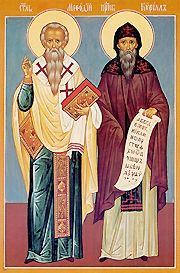
After the death of St Cyril, the Pope sent St Methodius to Pannonia, consecrating him as Archbishop of Moravia and Pannonia, on the ancient throne of St Andronicus. In Pannonia, St Methodius and his disciples continued to distribute services books written in the Slavonic language. This again aroused the wrath of the German bishops. They arrested and tried St Methodius, who was sent in chains to Swabia, where he endured many sufferings for two and a half years.
After being set free by order of Pope John VIII of Rome, and restored to his archdiocese, St Methodius continued to preach the Gospel among the Slavs. He baptized the Czech prince Borivoi, his wife Ludmilla and also one of the Polish princes. The German bishops began to persecute the saint for a third time, because he did not accept the erroneous teaching about the procession of the Holy Spirit from both the Father and the Son. St Methodius was summoned to Rome, but he justified himself before the Pope, and preserved the Orthodox teaching in its purity, and was sent again to the capital of Moravia, Velehrad.
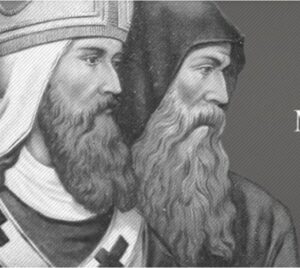
St Methodius, assisted by two of his former pupils, translated the entire Old Testament into Slavonic, except for the Book of Maccabees, and even the Nomo Canon (Rule of the holy Fathers) and Paterikon (book of the holy Fathers). Sensing the nearness of death, St Methodius designated one of his students, Gorazd, as a worthy successor to himself. The holy bishop predicted the day of his death conquered by efforts and torments and died in Nitra, on April 6, at the age of sixty, St. Methodius passed away in 885 AD. His disciples were subjected to torture and persecution. Some of them were sold as slaves. The saint’s burial service was chanted in three languages, Slavonic, Greek, and Latin. He was buried in the cathedral Church of Velehrad.
The two brothers have been recognized as saints, like the apostles, for their missionary work. The wide-spread veneration of Sts. Cyril and Methodius among the Slavic peoples began in the 19th century and became a symbol of self-determination of the cultures in the Slavic countries. After the two Saints reposed, attacks on their work continued, and their disciples were eventually driven from Moravia. And, of course, the alphabet that they devised, called Cyrillic after St Cyril, remains the standard alphabet of both the Slavonic service books of the Church and the Slavic languages of today. The brothers were successful educators and teachers and left an entire generation of disciples behind them. The activity of their generation of disciples was as important as that of the brothers themselves and help of disciples, their mission wouldn’t have had the results that were eventually attained. Many Churches and institutions have been dedicated to these two saints in the Slavonic region of the Eastern Orthodox Church es and are the Patron Saints of many Countries like Bulgaria, Czech Republic, Slovakia, Serbia The Order of Saints Cyril and Methodius, originally founded in 1909, is part of the national award system of Bulgaria. Sts. Cyril and Methodius, are commemorated on May 11, in the Eastern Orthodox and on February 14 in Catholic Churches.
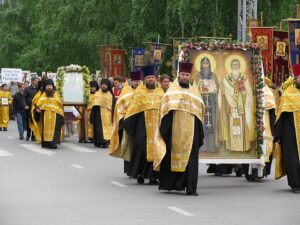

0 Comments